Class 122 DMU images
« ‹ Page 5 of 46, displaying 81-100 of 914 images › »

8th September 1966
Set: 104
55006 passes by at Lapworth with the 5.40pm Leamington - Snow Hill service on September 8th, 1966. Michael Mensing.
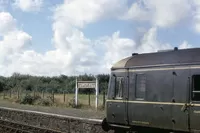
October 1966
The Wadebridge train arrives at Tower Hill on the north Cornwall line on last day of operation in October 1966. David Hawkings.
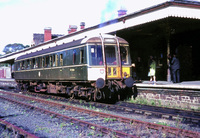
1st October 1966
1st of October 1966 was the last day of Services to Bude, The single car DMU (W55016) in the station will form the 15.20 from Halwill Junction. The KDH Archive.
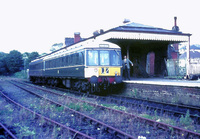
1st October 1966
1st of October 1966 was the last day of Services to Bude, as you can see some of the track was already looking neglected. The 16.45 to Halwill Junction is formed of two GRC&W vehicles, a DMBS ('bubble car') on the rear and closest a DTS which appears to be W56297. The KDH Archive.
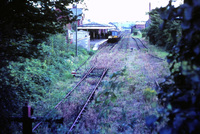
1st October 1966
1st of October 1966 was the last day of Services to Bude, as you can see some of the track was already looking neglected. The two single car DMU's ( a GRC&W bubble and DTS, thought to be W56297) in the station has arrived as the 16.00 from Halwill Junction. The KDH Archive.
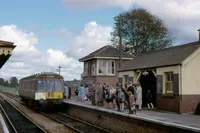
3rd October 1966
Crowds wait at Holsworthy Station to take the last train to Bude on 3 October 1966. The Southern Railway "target" sign has been retained, although the waiting shed has been repainted in "Western" colours. David Hawkings.
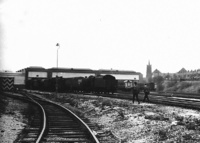
March 1967
Tyseley MPD, 03/67. In the yard are LMS Class "5MT's" Nos.44675, 44663, 44833, & 45296 and BR St.Cl." 5MT" No.73045, Brush Type 4 (Class 47) No.D1688, Gloucester RC&W Co. railcars (Class 122) Nos.W55006 & W55004 and BR (Derby) dmu trailer (Class 175) No.W59016. Hugh Llewelyn.

29th March 1967
W55017 at Looe on the 29th March 1967. Stuart Mackay Collection.
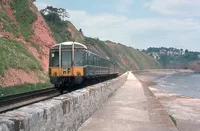
10th June 1967
WIth Paignton on the destination blind a GRC&W single car leads a two-car Cross-Country set at Teignmouth on 10 June 1967. Stuart Mackay Collection.

21st June 1967
GRC&W double-ender W55019 at Penarth on 21 June 1967 after arriving with the 1.50pm from Cadoxton. A Derby suburban triple set is behind. Robert Thomas.

circa late 1960s
GRC&W double-ender M55003 at Gloucester (Central). The early version of Rail Blue livery with the yellow panel and 3" numbers suggests late 1960s. Stuart Mackay Collection.

Unknown Date
A Class 122, taken at 5pm one February evening at Bristol Temple Meads. The year supplied with the image was 1973, but given the livery it will be a few years earlier. The station signage on the right is in the post-1965 style (black rail alphabet text on white). For most of the late 1960s Bristol had just 55013 allocated, and the low position of the flash in the cab window matches other images of the vehicle from that period, so it is presumed to be that vehicle. It would move to Scotland in Spring 1968. Adrian Vaughan.

11th May 1968
W55016 with the Plymouth Railway Circle Clayliner railtour at Fowey on 11 May 1968. Stuart Mackay Collection.

10th June 1968
55011 at Kilmarnock, waiting to depart with the 1:58pm to Ayr, 10th June 1968. Hamish Stevenson.

circa 1968
GRC&W DTC 56291 arrives into Motherwell station - no date, but the M predix should date it to soon after transfer from Tyseley to Hamilton in June 1968. Also in the formation is a GRC&W bubble, a three-car Derby Heavyweight (later Class 107) and possibly at least one more vehicle. Graham Clark.

circa 1968
GRC&W DTC M56291 and three GRC&W bubble cars at Rutherglen. Date unknown, but probably circa late 1968 after the DTC had been transferred from Tyseley to Hamilton. Graham Clark.

1969
A vintage view of the class 122 Stourbridge shuttle entering Stourbridge Junction in 1969. Stephen Burdett.
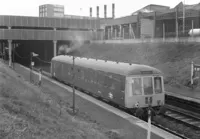
1969
Set: TY056
GRC&W single car M55012 departs from Spring Road station sometime in 1969. Shirley is on the destination blind. Stuart Mackay Collection.

circa 1969
On a rainy day at Kilmarnock Class 122 55011 runs into the bay platform, probably on a service from (or to form a service to) Ayr. Already in the platform is 55000, still with a W prefix. There's no yellow on the cab side, so it's carrying blue livery with small yellow panel. Circa 1969. Stuart Rankin.

circa 1969
Class 122 55011 seen in Ayr station on a service from Kilmarnock, circa 1969. Stuart Rankin.


